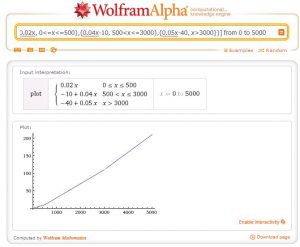

Geometrically speaking, is the slope of the tangent line of at. This limit is not guaranteed to exist, but if it does, is said to be differentiable at. Note for second-order derivatives, the notation is often used.Īt a point, the derivative is defined to be. These are called higher-order derivatives. When a derivative is taken times, the notation or is used. Given a function, there are many ways to denote the derivative of with respect to. What are derivatives? The derivative is an important tool in calculus that represents an infinitesimal change in a function with respect to one of its variables.

#WOLFRAMALPHA GRAPHER GENERATOR#
Get immediate feedback and guidance with step-by-step solutions and Wolfram Problem Generator
#WOLFRAMALPHA GRAPHER HOW TO#
Here are some examples illustrating how to ask for a derivative. To avoid ambiguous queries, make sure to use parentheses where necessary. Learn what derivatives are and how Wolfram|Alpha calculates them.Įnter your queries using plain English. Wolfram|Alpha is a great calculator for first, second and third derivatives derivatives at a point and partial derivatives. As always, we look forward to reading your feedback and bringing you more fun and useful abilities in the future.More than just an online derivative solver This new ability to analyze discontinuities is part of our ongoing effort to make Wolfram|Alpha the best possible mathematical knowledge engine. For example, Wolfram|Alpha finds the “poles” of a function on the complex plane, giving their orders and residues: While Wolfram|Alpha can’t find and analyze all of them, it can analyze some other useful classes of them. Higher-dimensional functions also have discontinuities, of course, which can be infinitely more complicated than those on the real line. The discontinuities of a parametric function are just where any of its component functions have a discontinuity: In the case of sin( x) / x, defining the value at x = 0 to be 1 (the value of the limit at x = 0) yields an important continuous function for communications engineering: the “sinc” function.Ī more exotic kind of discontinuity is found in the function sin: at x = 0, the left- and right-hand limits do not exist and are also not infinite, because the function oscillates infinitely often between -1 and 1, a fact which Wolfram|Alpha (with help from Mathematica) is able to figure out. If we do this with ( x – 1) / ( x – 1), we just get the constant function f( x) = 1. We can think of “removing” a removable discontinuity by just defining a function that is equal to the limit at the point of discontinuity, and the same otherwise. A simple example is ( x – 1) / ( x – 1), which is equal to 1 everywhere except at x = 1, where it is undefined. This is where the left- or right-hand limits are both the same real number (not infinity), but not equal to the value of the function. The final type of discontinuity is called a “removable” discontinuity. Clicking the Show limits button reveals this information: This is epitomized by the “unit step” function (think of flipping on a light switch).īesides finding the discontinuities, Wolfram|Alpha will attempt to compute the left- and right-hand limits at each discontinuity as well as the value of the function at the discontinuity, if it exists. 1/x is the standard example:Ī “jump” discontinuity is where the left- or right-hand limits are both real numbers (not infinity) but are not equal. When it comes to such functions, there are three main kinds of discontinuities.Īn “infinite” discontinuity is a point where the function increases to infinity and/or decreases to negative infinity (i.e., where it has a vertical asymptote).

Wolfram|Alpha now has the ability to find and analyze the discontinuities of most functions of real numbers. In technical language, a discontinuity of a function from reals to reals is a point where either the left- or right-hand limit does not exist, or where these limits exist but aren’t both equal to the value of the function at this point. Thought of another way, a continuous function is one you can graph without having to lift your pen up from the paper.Ĭonversely, a discontinuity of a function is a point where the value of the function experiences a sudden change.

Most functions that we see every day, from the parabolic arc of a thrown ball to the exponential growth of money in a bank account, are “continuous.” That is, they don’t change their value suddenly. This first exposure comes through studying limits and discontinuities. It’s usually in precalculus class that students are first exposed to the more exotic and subtle aspects of functions on the real line.


 0 kommentar(er)
0 kommentar(er)
